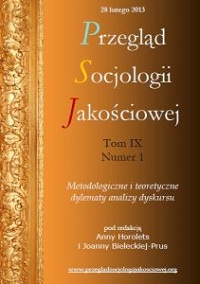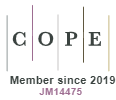Interakcja w miejscu pracy z perspektywy kilku podejść dyskursywnych
DOI:
https://doi.org/10.18778/1733-8069.9.1.07Słowa kluczowe:
analiza konwersacyjna, krytyczna analiza dyskursu, analiza dyskursu, psychologia dyskursywna, interakcyjna socjolingwistyka, teoria grzeczności, pragmatyka, interakcja w miejscu pracyAbstrakt
W artykule omówiono wkład pięciu różnych podejść w ramach analizy dyskursu w interpretację i zrozumienie tego samego materiału empirycznego. Podejścia wybrane do porównania to analiza konwersacyjna, interakcyjna socjolingwistyka, teoria grzeczności, krytyczna analiza dyskursu i psychologia dyskursywna. Dane empiryczne stanowi dziewięciominutowe nagranie dźwiękowe nieformalnej interakcji w miejscu pracy. W artykule zostaną ze sobą zestawione różne sposoby analizy, zostaną również omówione teoretyczne i metodologiczne implikacje używania poszczególnych podejść.
Pobrania
Bibliografia
Brown Penelope, Levinson Stephen C. (1978) Universals in Language Usage: Politeness Phenomena [w:] Esther N. Goody, ed., Questions and Politeness: Strategies in Social Interaction. Cambridge: Cambridge University Press, s. 56‒289.
Google Scholar
Brown Penelope, Levinson Stephen C. (1987 [1978]) Politeness: Some Universals in Language Usage. Cambridge: Cambridge University Press.
Google Scholar
DOI: https://doi.org/10.1017/CBO9780511813085
Couper-Kuhlen Elisabeth, Selting Margret, eds., (1996) Prosody in Conversation: Interactional Studies. Cambridge: Cambridge University Press.
Google Scholar
DOI: https://doi.org/10.1017/CBO9780511597862
Edelsky Carole (1981) Who’s Got the Floor? „Language in Society”, vol. 10, no. 3, s. 383‒421.
Google Scholar
DOI: https://doi.org/10.1017/S004740450000885X
Edwards Derek, Jonathan Potter (1992) Discursive Psychology. London: Sage.
Google Scholar
van Dijk Teun A. (1998) Principles of Critical Discourse Analysis [w:] Jenny Cheshire, Peter Trudgill, eds., The Sociolinguistics Reader Volume 2: Gender and Discourse. London: Arnold, s. 367–91.
Google Scholar
van Dijk Teun A. (1999) Editorial: Critical Discourse Analysis and Conversation Analysis. „Discourse and Society”, vol. 10, no. 4, s.459–60.
Google Scholar
DOI: https://doi.org/10.1177/0957926599010004001
Fairclough Norman (1989) Language and Power. London: Longman.
Google Scholar
Gill Rosalind (1993) Justifying Injustice: Broadcasters’ Accounts of Inequality in Radio [w:] Erica Burman, Ian Parker, eds., Discourse Analytic Research. Repertoires & Readings of Texts in Action. London: Routledge, s. 75–93.
Google Scholar
Goffman Erving (1967) Interaction Ritual: Essays on Face to Face Behaviour. New York: Anchor Books.
Google Scholar
Gough Brendan (1998) Men and the Discursive Reproduction of Sexism: Repertoires of Difference and Equality. „Feminism and Psychology”, vol. 8, no. 1, s. 25–49.
Google Scholar
DOI: https://doi.org/10.1177/0959353598081003
Gumperz John J. (1982) Discourse Strategies. Cambridge: Cambridge University Press.
Google Scholar
DOI: https://doi.org/10.1017/CBO9780511611834
Gumperz John J. (1992) Interviewing in Intercultural Situations [w:] Paul Drew, John Heritage, eds., Talk at Work: Interaction in Institutional Settings. Cambridge: Cambridge University Press, s. 302–307.
Google Scholar
Gumperz John J. (1999) On Interactional Sociolinguistic Method [w:] Srikant Sarangi, Celia Roberts, eds., Talk, Work and Institutional Order: Discourse in Medical, Mediation and Management Settings. Berlin: Mouton de Gruyter, s. 453–471.
Google Scholar
DOI: https://doi.org/10.1515/9783110208375.4.453
ten Have Paul (1999) Doing Conversation Analysis: A Practical Guide. Thousand Oaks: Sage.
Google Scholar
Heritage John, ed., (1984) Conversation Analysis [w:] Garfinkel and Ethnomethodology. Cambridge: Polity Press, s. 233–292.
Google Scholar
Holmes Janet (2000) Women at Work: Analysing Women’s Talk in New Zealand Workplaces. „Australian Association of Applied Linguistics”, no. 22, s. 1–17.
Google Scholar
DOI: https://doi.org/10.1075/aral.22.2.01hol
Holmes Janet, Stubbe Michaeli, Vine Bernadette (1999) Constructing Professional Identity: “Doing Power” in Policy Units [w:] Srikant Sarangi, Celia Roberts, eds., Talk, Walk and Institutional Order: Discourse in Medical, Mediation and Management Settings. Berlin: Mouton de Gruyter, s. 351–385.
Google Scholar
DOI: https://doi.org/10.1515/9783110208375.3.351
Hutchby Ian, Wooffitt Robin (1998) Conversation Analysis: Principles, Practices and Applications. Cambridge: Polity Press.
Google Scholar
Kress Gunther (1990) Critical Discourse Analysis. „Annual Review of Applied Linguistics”, no. 11, s. 84–99.
Google Scholar
DOI: https://doi.org/10.1017/S0267190500001975
Levinson Stephen C., ed., (1983) Conversational Structure [w:] Pragmatics. Cambridge: Cambridge University Press, s. 284–370.
Google Scholar
DOI: https://doi.org/10.1017/CBO9780511813313.009
Morand David A. (1996) Dominance, Deference, and Egalitarianism in Organizational Interaction: A Sociolinguistic Analysis of Power and Politeness. „Organization Science”, vol. 7, no. 5, s. 544–556.
Google Scholar
DOI: https://doi.org/10.1287/orsc.7.5.544
Nikander Pirjo (1995) The Turn to the Text: The Critical Potential of Discursive Social Psychology. „Nordiske Udkast”, no. 2, s. 3–15.
Google Scholar
Paltridge Brian (2000) Making Sense of Discourse Analysis. Gold Coast: Antipodean Educational Enterprise.
Google Scholar
Pomerantz Anita, Fehr Barbara J. (1997) Conversation Analysis: An Approach to the Study of Social Action as SenseMaking Practices [w:] Tuan A. van Dijk, ed., Discourse as Social Interaction. London: Sage, s. 64–91.
Google Scholar
Potter Jonathan (1996) Representing Reality: Discourse, Rhetoric and Social Construction. London: Sage.
Google Scholar
DOI: https://doi.org/10.4135/9781446222119
Potter Jonathan, Wetherell Margaret (1987) Discourse and Social Psychology. London: Sage.
Google Scholar
Psathas George (1995) Conversation Analysis: The Study of Talk-in-Interaction. Thousand Oaks: Sage.
Google Scholar
DOI: https://doi.org/10.4135/9781412983792
Rancew-Sikora Dorota (2007) Analiza konwersacyjna jako metoda badania rozmów codziennych. Warszawa: Trio.
Google Scholar
Rapley Tim (2010) Analiza konwersacji, dyskursu i dokumentów. Przełożyła Anna Gąsior-Niemiec. Warszawa: Wydawnictwo Naukowe PWN.
Google Scholar
Roberts Celia, Davies Evelyn, Jupp Tom (1992) Language and Discrimination: A Study of Communication in Multi-ethnic Workplaces. London: Longman.
Google Scholar
Sacks Harvey (1984) Notes on methodology [w:] J. Maxwell Atkinson, John J. Heritage, eds., Structures of Social Action: Studies in Conversation Analysis. Cambridge: Cambridge University Press, s. 21–27.
Google Scholar
Sacks Harvey (1992) Lectures on Conversation (2 tomy). Oxford: Blackwell.
Google Scholar
Schegloff Emanuel A. (1993) Reflections on Quantification in the Study of Conversation. „Research on Language and Social Interaction”, vol. 26, no. 1, s. 99–128.
Google Scholar
DOI: https://doi.org/10.1207/s15327973rlsi2601_5
Schiffrin Deborah (1994) Approaches to Discourse. Oxford: Blackwell.
Google Scholar
Schiffrin Deborah (1996) Interactional Sociolinguistics [w:] Sandra Lee McKay, Nancy H. Hornberger, eds., Sociolinguistics and Language Teaching. Cambridge: Cambridge University Press, s. 307–28.
Google Scholar
DOI: https://doi.org/10.1017/CBO9780511551185.014
Sollitt-Morris Lynnette (1996) Language, Gender and Power Relationships: The Enactment of Repressive Discourse in Staff Meetings of Two Subject Departments in a New Zealand Secondary School. Niepublikowana praca doktorska, [maszynopis]. Victoria University of Wellington, New Zealand.
Google Scholar
Thomas Jenny (1995) Meaning in Interaction. New York: Longman.
Google Scholar
Titscher Stefan, Meyer Michael, Wodak Ruth, Vetter Eva (2000) Methods of Text and Discourse Analysis. London: Sage.
Google Scholar
Wetherell Margaret, Stiven Hilda, Potter Jonathan (1987) Unequal Egalitarianism: A Preliminary Study of Discourses and Employment Opportunities. „British Journal of Social Psychology”, no. 26, s. 59–71.
Google Scholar
DOI: https://doi.org/10.1111/j.2044-8309.1987.tb00761.x
Wieder D. Lawrence, ed., (1993) On the Compound Questions Raised by Attempts to Quantify Conversation Analysis’ Phenomena. „Research on Language and Social Interaction”, vol. 26, no. 2, s. 151–226.
Google Scholar
DOI: https://doi.org/10.1207/s15327973rlsi2602_2
Pobrania
Opublikowane
Jak cytować
Numer
Dział
Licencja

Utwór dostępny jest na licencji Creative Commons Uznanie autorstwa – Użycie niekomercyjne – Bez utworów zależnych 4.0 Międzynarodowe.














